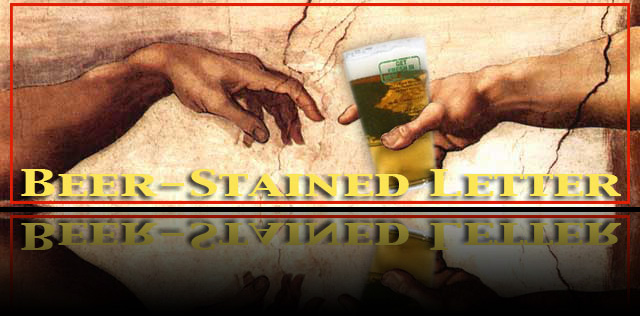A touch of high tech in brewing
 Flying Fish, New Jersey's largest craft brewer and one of its oldest, is on pace to say goodbye to its foundig location in CherryHill in a month's time.
Flying Fish, New Jersey's largest craft brewer and one of its oldest, is on pace to say goodbye to its foundig location in CherryHill in a month's time.
Elsewhere, by that July 1 date's arrival, the folks at the state's smallest and one of its newest craft breweries, Flounder Brewing, expect to have some test brews under their belt.
One of the interesting things about these evens its the fact that at both breweries, computerized touchscreen displays will be used to control the process of making beer.
For several weeks now, the custom German-made BrauKon 50-barrel brewhouse and complement of 150-barrel fermenters (not to mention other tanks) have been in place at Flying Fish's new home in Somerdale.
It's an almost-there, just a little further moment.

Also, the month of May saw Flying Fish put the new brewhouse through the paces with some test batches of Extra Pale Ale, Hopfish IPA and Farmhouse Summer Ale. (Folks at Flying Fish report the better efficiency between the new brewing set-up vs. the old is rather dramatic; that will translate into less grain used per batch, which of course will save money in raw materials.)
 Setting that brewing process in motion – from grain into (and out of) the mash tun to regulating fermenter temperatures, for instance – is an illuminated touchscreen control panel tucked beneath brewhouse framework.
Setting that brewing process in motion – from grain into (and out of) the mash tun to regulating fermenter temperatures, for instance – is an illuminated touchscreen control panel tucked beneath brewhouse framework.
Featuring computer icons of all the components the brewing process – the grain silos, mash tun, lauter tun, kettle, fermenter tanks, etc. – the display panel is driven by software into which the recipes, parameters and procedures for Flying Fish's lineup of ales (and down the road, head brewer Casey Hughes says there will be lagers) have been programmed, shifting the task of creating beer from the sometimes physically laborious to the feather touch of tapping glass.
But wait it gets better.
The system can be operated remotely, too. Imagine sitting at your favorite bar with a pint of Exit 8 in front of you, logging in via an iPhone to check the temperature of beer in the fermenters or the status of other tanks.
And in case you get the impression that high tech takes the hands out of hand-crafted, then guess again. The human touch starts with formulating the recipes and continues with some taste bud and olfactory follow-up on the beers produced, to ensure what was brewed turned out the way it was intended.
 The automated set-up that Flying Fish-Somerdale has graduated to puts the South Jersey brewery in league with the likes of Pennsylvania brewers Troegs, Sly Fox and Victory. It's also move toward ensuring the kind of consistency the beer-drinking public would expect.
The automated set-up that Flying Fish-Somerdale has graduated to puts the South Jersey brewery in league with the likes of Pennsylvania brewers Troegs, Sly Fox and Victory. It's also move toward ensuring the kind of consistency the beer-drinking public would expect.
But such automation isn't always the province of becoming a bigger brewery. In a world where technology can change faster than a bar's tap handle lineup during seasonal beer releases, touchscreen control panels are available to breweries of all sizes.
Just go 60 miles north of Somerdale to Hillsborough, where the budding Flounder Brewing has a touchscreen to operate its 1-barrel Blichmann set-up. (The brewery last week got the official blessing from town officials to occupy the building; state regulators gave the green light to Flounder's license back in early March. There are still some odds and ends to take care of, but the folks at Flounder expect to begin brewing some test batches in June.)
 It was engineering mistake that led Flounder to include in its game plan a $9,000 touchscreen controller made by Brewmation, a Hopewell Junction, N.Y., company. The size of the brewery's natural gas line was found to be a quarter-inch too small, a BTU drop that meant either upgrading – and incurring a potentially lengthy delay – or switch to electric, which the brewery did.
It was engineering mistake that led Flounder to include in its game plan a $9,000 touchscreen controller made by Brewmation, a Hopewell Junction, N.Y., company. The size of the brewery's natural gas line was found to be a quarter-inch too small, a BTU drop that meant either upgrading – and incurring a potentially lengthy delay – or switch to electric, which the brewery did.
Jeremy Lees, who owns the start-up with his two brothers, a brother-in-law and a cousin, says the mistake proved to be fortuitous. All of the Flounder principals will be leading the lives of brewery owners with the full-time jobs they had before getting into commercial brewing. Anything that will ensure consistency from batch to batch is a plus, Jeremy says, not to mention that down the road, they could add remote log-in capability to their set-up to control some of the beer-making process from those day jobs – or wherever – via a smart phone.
 |
| Closeup of Flounder touchscreen |
Brewmation has been making the touchscreen controller since 2010; the company has been making control panels for craft breweries for almost 10 years, with units installed at the New York enterprises of Rockaway Brewing and Good Nature Brewing, says Kevin Weaver, a longtime homebrewer and one of the electrical engineer minds behind Brewmation. (Kevin also has his own 7-barrel brewery in the works.)
On the hot side, you need an electric set-up to be wired into the Brewmation controller (it doesn't support natural gas rigs), but it's universal on the fermentation side. (The units cost $9,000 to $12,000.)
Even for small-size breweries, the steps in brewing "screamed out to be automated," Kevin says. "That's how the whole thing started."














No comments:
Post a Comment